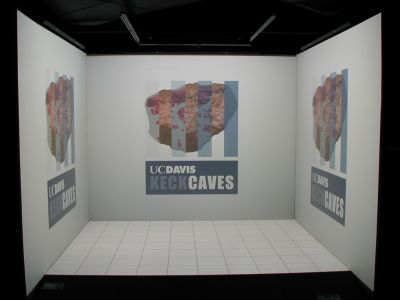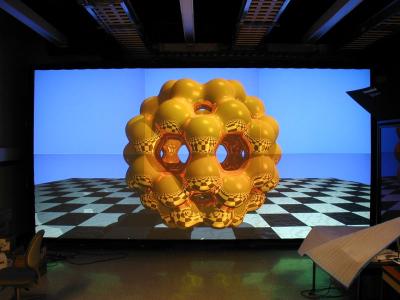
















Note: The Jedi tool was not added in post-processing by rotoscoping, but rendered in real time inside the immersive environment alongside the Quake 3 arena map, based on the wand input device's position and orientation.












 |
Picture of the KeckCAVES CAVE showing the idle image. The three walls are rear-projected, and the floor is front-projected via a mirror hanging above the CAVE structure. The black bars affixed to the ceiling are ultrasound emitter strips for the tracking system. |
| A StereoGraphics CrystalEyes shutter goggle with the attached InterSense IS-900 wireless head tracker. The head tracker is tracked in position and orientation, and provides accurate eye positions to create immersive stereoscopic images. | |
 |
The InterSense IS-900 wireless wand. The wand is tracked in position and orientation, and has six buttons and an analog joystick to interact with VR applications. |
 |
The CAVE console and control workstation. The control workstation is a commodity server with dual 2.2GHz AMD Opteron CPUs, NVIDIA Geforce 6600 graphics board, and 3GB of main memory, running Red Hat Enterprise Linux. The control workstation communicates directly with the tracking system, and synchronizes the four render nodes and the audio processing node. It is connected to the outside world via 100Mb Ethernet. |
 |
One of the racks housing the CAVE computer system. This rack, located right next to the control workstation, houses the tracking system (top slot), the audio processing node, the 1Gb Ethernet switch, the audio mixer board, and one of the render nodes. One of the CAVE wall projector assemblies is visible in the background. |
 |
The second rack, housing three additional render nodes. The render nodes are commodity computers with single 2.2GHz AMD Athlon 64 CPUs, NVIDIA Quadro FX 4400 graphics boards with G-sync daughter boards, and 2GB of main memory, running Red Hat Enterprise Linux. The audio processing node is identical, minus the graphics board. All computers in the CAVE cluster are connected via 1Gb Ethernet. |
 |
One of the three wall projectors and the mirror used to fold the light path to minimize the CAVE's footprint. These are Christie Digital Mirage S+4K stereo-capable three-chip DLP projectors with a native resolution of 1400x1050 pixels (KeckCAVES uses only 1280x1024 pixels per screen) and very high 6500 ANSI lumens light output. The small box mounted to the projector (on top in the mirror image) is the infrared emitter used to synchronize the active stereo image with the shutter goggles. |
 |
Another view of the same wall projector assembly facing on of the CAVE screens. |
 |
A view of the floor projector hanging above the rear screen. The floor projection mirror, hanging above the CAVE structure, is visible in the center-left part of the image. |
 |
A user interacting with a model of Earth, showing the surface with texture-mapped continents and oceans, the outer and inner core, and a database of hypocenters of about 60,000 earthquakes of magnitude 5.0 or more that occurred during the last 67 years. |
 |
Model of Earth showing only the surface texture. Notice how the model appears virtually seamless even though it spans two of the CAVE walls. This photo was taken from the proper viewing position to ensure seamless projection onto any CAVE screen. |
 |
The exact same display on the CAVE screens, photographed from a different viewpoint. Notice how both halves of the image appear distorted, especially the right half. This photo shows why head tracking, and proper calculation of the screen projections, are essential for using stereoscopic display systems such as CAVEs effectively. |
 |
A user interacting with an application to analyze ultra high-resolution ground-based LiDAR data, in this case a scan of the UC Davis water tower and Mondavi Center. The yellow sphere attached to the wand is a "3D paint brush" used to select points (highlighted in green) which are later used to extract mathematical representations of surface features. Also see the movie (MPEG-1, 27MB) of a user working with this data set, which was provided by Gerald Bawden of the US Geological Survey. |
 |
Another LiDAR Viewer example; this time, a real user (former Master's student Peter Gold), working with an airborne scan of the El Mayor-Cucapah fault after the April 2010 earthquake. Peter spent approximately 150 hours in the CAVE, working with this particular data set. This picture was taken approximately 100 hours in, hence the relaxed stance. |
 |
A 3D protein model displayed using the VR version of ProtoShop. Also see the movie (MPEG-1, 22MB) of a user manipulating this protein. |
 |
A user interacting with a block of "virtual Jell-O." The Jell-O is modeled as a cubic-lattice arrangement of "Jell-O atoms;" the interactions between bonded Jell-O atoms are simulated using a simple force field model computed by a fourth-order Runge-Kutta-Nystrom ODE solver, and the Jell-O crystal is rendered as six transparent bicubic B-spline patches defined by the Jell-O atoms on each face of the crystal as control points. The Jell-O's flavor is "virtual lime." |
 |
The "Hello, World!" of VR -- a viewer for Quake 3 Arena maps. This one is based on the Aftershock rendering engine and the CAVE Quake wrapper by Paul Rajlich. |
 |
A user defending herself against virtual foes using Vrui's "Jedi tool." Note: The Jedi tool was not added in post-processing by rotoscoping, but rendered in real time inside the immersive environment alongside the Quake 3 arena map, based on the wand input device's position and orientation. |
 |
The 18'x9' tiled active-stereo display wall in IDAV's virtual reality lab. Each of the 3x2 tiles is run by two LCD projectors at a resolution of 1024x768 pixels (leading to a total resolution of 3072x1536 pixels), and the wall uses an external shutter system to time-interleave the two sets of images for the left and right eye. The wall uses an InterSense IS-900 tracking system with two wired head trackers and a wired wand. It is controlled by a cluster of nine Linux computers (one head node, one render node per tile, two audio nodes). |
 |
IDAV's display wall is 100% software-compatible with KecKCAVES' CAVE, which is achieved using our Vrui VR toolkit. This picture shows the display wall with its default background image, a raytraced image of a reflective C-60 Buckminsterfullerene ("Buckyball") that, for some unknown reason, is hovering over a chessboard. |
 |
The IDAV display wall running a 2D Vrui-based application to render ultra-high resolution images. This example is an aerial photograph of the city of Davis, generously made available by the City of Davis, at a size of approximately 64,000x32,000 pixels. The program uses an out-of-core multiresolution image rendering algorithm to display arbitrary views of the data at very high frame rates, even when running on a cluster with a commodity network interconnect (like the nine-node, gigabit Ethernet cluster we have). Even though the program displays 2D data, it still uses the display wall's tracked 3D input devices for navigation. |
 |
The tiled display wall, running the Nanotech Construction Kit to explain the molecular structure of fullerenes to a group of high school students visiting UC Davis as part of the COSMOS summer education program in 2007. The display seems "blurry" because the display wall is showing stereo images, one for the left eye and one for the right eye, and the camera is not wearing stereo glasses. |
 |
A behind-the-scenes look at the tiled display wall's projector rack, holding twelve projectors total in 3x2 pairs of two. In each pair, the upper projector generates the right-eye image, and the lower projector generates the left-eye image. This picture was taken before the external liquid crystal shutters were installed. |
 |
IDAV's oldest VR environment, the FakeSpace Responsive Workbench. It has a Polhemus Fastrak tracking system with four sensors, and FakeSpace Pinch Gloves. |
 |
An ImmersaDesk temporarily loaned to IDAV by Lawrence Berkeley National Laboratory's visualization group. The device, which is now back in Berkeley, is used here to create a quartz crystal using the Nanotech Construction Kit. |
 |
IDAV's tiled powerwall, a non-stereo display with an attached Ascension Flock of Birds tracking system and FakeSpace Pinch Gloves. This picture shows a user manipulating a protein structure using ProtoShop. |
 |
IDAV's tiled powerwall running a different Vrui application, 3D Visualizer (downloadable from here). This time, the user is controlling the application using a 3DConnexion Spaceball 4000 FLX 6-DOF spaceball device. |
 |
The passive-stereo single-screen visualization environment we recently helped installing at the Tahoe Center for Environmental Sciences. It is a 12'x9' screen driven by a single Macintosh Pro computer. The environment is mostly used for public education and outreach, and is currently running several KeckCAVES applications. It is controlled by a docent using a joystick or spaceball device. |
 |
The screen is located on the ground floor of the building, in the Otellini Visualization Center. It offers seating room for about 20 visitors. |
 |
The two 1400x1050 LCD projectors are ceiling-mounted and use linear polarization for stereo separation. |